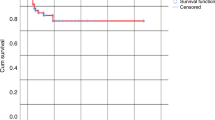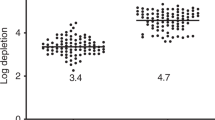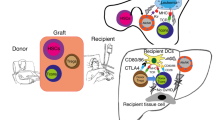Summary:
A dog model of stable mixed hematopoietic chimerism was established in which leukocyte-antigen-identical littermates receive nonmyeloablative total body irradiation before hematopoietic cell transplantation and postgrafting immunosuppression with mycophenolate mofetil and cyclosporine. Unmodified donor lymphocyte infusion (DLI) into stable mixed chimeras failed to increase donor chimerism, while DLI from donors sensitized to recipient minor-histocompatibility antigens promptly converted all recipients to complete donor chimerism. This established a model for studying approaches to enhance the graft-versus-host (GVH)-effect, a potential surrogate for graft-versus-leukemia activity. We asked if interleukin-2 (IL-2) given after unmodified DLI could result in reliable conversion to complete donor chimerism. IL-2, 4 × 105 IU/kg/day, was administered to six mixed chimeric dogs for 14 days. Four dogs received unmodified DLI with IL-2. At 20–40 weeks after DLI, all dogs remained mixed chimeras. For the two recipients of IL-2 only, mixed chimerism also remained unchanged. These results show that IL-2 given with DLI after nonmyeloablative transplantation in dogs is not effective in reliably converting mixed to complete donor chimerism.
This is a preview of subscription content, access via your institution
Access options
Subscribe to this journal
Receive 12 print issues and online access
$259.00 per year
only $21.58 per issue
Buy this article
- Purchase on Springer Link
- Instant access to full article PDF
Prices may be subject to local taxes which are calculated during checkout


Similar content being viewed by others
References
Storb R, Yu C, Wagner JL et al. Stable mixed hematopoietic chimerism in DLA-identical littermate dogs given sublethal total body irradiation before and pharmacological immunosuppression after marrow transplantation. Blood 1997; 89: 3048–3054.
McSweeney PA, Niederwieser D, Shizuru JA et al. Hematopoietic cell transplantation in older patients with hematologic malignancies: replacing high-dose cytotoxic therapy with graft-versus-tumor effects. Blood 2001; 97: 3390–3400.
Childs R, Clave E, Contentin N et al. Engraftment kinetics after nonmyeloablative allogeneic peripheral blood stem cell transplantation: full donor T-cell chimerism precedes alloimmune responses. Blood 1999; 94: 3234–3241.
Horwitz ME, Barrett AJ, Brown MR et al. Treatment of chronic granulomatous disease with nonmyeloablative conditioning and a T-cell-depleted hematopoietic allograft. N Engl J Med 2001; 344: 881–888.
Shlomchik WD, Couzens MS, Tang CB et al. Prevention of graft versus host disease by inactivation of host antigen-presenting cells. Science 1999; 285: 412–415.
Georges GE, Storb R, Thompson JD et al. Adoptive immunotherapy in canine mixed chimeras after nonmyeloablative hematopoietic cell transplantation. Blood 2000; 95: 3262–3269.
Kolb HJ, Schattenberg A, Goldman JM et al. Graft-versus-leukemia effect of donor lymphocyte transfusions in marrow grafted patients. European Group for Blood and Marrow Transplantation Working Party Chronic Leukemia. Blood 1995; 86: 2041–2050.
Mackinnon S, Papadopoulos EB, Carabasi MH et al. Adoptive immunotherapy evaluating escalating doses of donor leukocytes for relapse of chronic myeloid leukemia after bone marrow transplantation: separation of graft-versus-leukemia responses from graft-versus-host disease. Blood 1995; 86: 1261–1268.
Porter DL, Roth MS, McGarigle C et al. Induction of graft-versus-host disease as immunotherapy for relapsed chronic myeloid leukemia. N Engl J Med 1994; 330: 100–106.
Kolb H-J . Management of relapse after hematopoietic cell transplantation. In: Thomas ED, Blume KG, Forman SJ (eds) Hematopoietic Cell Transplantation, 2nd edn. Blackwell Science: Boston, 1999, pp 929–936.
Sykes M, Harty MW, Szot GL, Pearson DA . Interleukin-2 inhibits graft-versus-host disease-promoting activity of CD4+ cells while preserving CD4- and CD8-mediated graft-versus-leukemia effects. Blood 1994; 83: 2560–2569.
Vourka-Karussis U, Ackerstein A, Pugatsch T, Slavin S . Allogeneic cell-mediated immunotherapy for eradication of minimal residual disease: comparison of T-cell and IL-2 activated killer (LAK) cell-mediated adoptive immunotherapy in murine models. Exp Hematol 1999; 27: 461–469.
Slavin S, Naparstek E, Nagler A et al. Allogeneic cell therapy with donor peripheral blood cells and recombinant human interleukin-2 to treat leukemia relapse after allogeneic bone marrow transplantation. Blood 1996; 87: 2195–2204.
Ladiges WC, Storb R, Graham T, Thomas ED . Experimental techniques used to study the immune system of dogs and other large animals. In: Gay WI, Heavener JE (eds) Methods of Animal Experimentation. Academic Press: New York, NY, 1989, pp 103–133.
Wagner JL, Burnett RC, DeRose SA et al. Histocompatibility testing of dog families with highly polymorphic microsatellite markers. Transplantation 1996; 62: 876–877.
Wagner JL, Burnett RC, Works JD, Storb R . Molecular analysis of DLA-DRBB1 polymorphism. Tissue Antigens 1996; 48: 554–561.
Sandmaier BM, Storb R, Santos EB et al. Allogeneic transplants of canine peripheral blood stem cells mobilized by recombinant canine hematopoietic growth factors. Blood 1996; 87: 3508–3513.
Storb R, Yu C, Zaucha JM et al. Stable mixed hematopoietic chimerism in dogs given donor antigen, CTLA4Ig, and 100 cGy total body irradiation before and pharmacologic immunosuppression after marrow transplant. Blood 1999; 94: 2523–2529.
Zaucha JM, Zellmer E, Georges G et al. G-CSF-mobilized peripheral blood mononuclear cells added to marrow facilitates engraftment in nonmyeloablated canine recipients: CD3 cells are required. Biol Blood Marrow Transplant 2001; 7: 613–619.
Storb R, Raff RF, Graham T et al. Marrow toxicity of fraction-ated versus single dose total body irradiation is identical in a canine model. Int J Radiat Oncol Biol Phys 1993; 26: 275–283.
Yu C, Ostrander E, Bryant E et al. Use of (CA)n polymorphisms to determine the origin of blood cells after allogeneic canine marrow grafting. Transplantation 1994; 58: 701–706.
Sandmaier BM, Schuening FG, Bianco JA et al. Biochemical characterization of a unique canine myeloid antigen. Leukemia 1991; 5: 125–130.
Schwarzinger I, Raff RF, Flowers M et al. Recipient-specific donor cytotoxic T-lymphocytes enhance engraftment of unrelated, DLA-nonidentical canine marrow. Bone Marrow Transplant 1994; 13: 303–309.
Samuel S, Nagler A, Or R, Slavin S . Effects of interleukin 2 on engraftment following autologous bone marrow transplantation (ABMT) in dogs. Leukemia Res 1992; 16: 967–972.
Georges GE, Storb R, Bruno B et al. Engraftment of DLA-haploidentical marrow with ex vivo expanded, retrovirally trans-duced cytotoxic T lymphocytes. Blood 2001; 98: 3447–3455.
Fefer A, Robinson N, Benyunes MC et al. Interleukin-2 therapy after bone marrow or stem cell transplantation for hematologic malignancies. Cancer J Sci Am 1997; 3: S48–S53.
Robinson N, Sanders JE, Benyunes MC et al. Phase I trial of interleukin-2 after unmodified HLA-matched sibling bone marrow transplantation for children with acute leukemia. Blood 1996; 87: 1249–1254.
Storb R, Yu C, Barnett T et al. Stable mixed hematopoietic chimerism in dog leukocyte antigen-identical littermate dogs given lymph node irradiation before and pharmacologic immunosuppression after marrow transplantation. Blood 1999; 94: 1131–1136.
Zaucha JM, Yu C, Zellmer E et al. Effects of extending the duration of postgrafting immunosuppression and substituting granulocyte-colony-stimulating factor-mobilized peripheral blood mononuclear cells for marrow in allogeneic engraftment in a nonmyeloablative canine transplantation model. Biol Blood Marrow Transplant 2001; 7: 513–516.
Smith KA . Rational interleukin-2 therapy. Cancer J Sci Am 1997; 3 (Suppl. 1): S137–S140.
Heslop HE, Gottlieb DJ, Bianchi AC et al. In vivo induction of gamma interferon and tumor necrosis factor by interleukin-2 infusion following intensive chemotherapy or autologous marrow transplantation. Blood 1989; 74: 1374–1380.
Gottlieb DJ, Prentice HG, Heslop HE et al. Effects of recombinant interleukin-2 administration on cytotoxic function following high-dose chemo-radiotherapy for hematological malignancy. Blood 1989; 74: 2335–2342.
Murphy WJ, Longo DL . The potential role of NK cells in the separation of graft-versus-tumor effects from graft-versus-host disease after allogeneic bone marrow transplantation (Review). Immunol Rev 1997; 157: 167–176.
Acknowledgements
We are grateful to the technicians of the Shared Canine Resource and the Hematology and Transplantation Biology Laboratories for their technical assistance. We gratefully acknowledge Dr John L Wagner, MD and James Works for DLA typing, and thank Benjamin Weigler, DVM, PhD, and Michelle Spector, DVM, who provided veterinary support. We are very grateful to Bonnie Larson, Helen Crawford, Lori Ausburn, Sue Carbonneau and Karen Carbonneau for their outstanding administrative support. We thank Dr Raymond Tesi and Leila Nawbatt, SangStat, Freemont, CA, for providing Cyclosporine (SangCya®, Cyclosporine Oral solution), Dr Sabine Hadulco, Roche Bioscience, Nutley, NJ, for providing mycophenolate mofetil, and Amgen Inc., Thousand Oaks, CA, for recombinant canine G-CSF. This work was supported in part by Grants DK02753, DK42716, HL63457, CA78902 awarded by the National Institutes of Health, DHHS, Bethesda, MD, USA. RS also received support from the Laura Landro Salomon Endowment Fund and a prize from the Josef Steiner Krebsstiftung, Bern, Switzerland. JMZ is a postdoctoral fellow from the Department of Hematology, University Medical School, Gdańsk, Poland, and is also a recipient of the International Fellowship for Young PhDs, awarded by the Foundation for Polish Science, Warsaw, Poland.
Author information
Authors and Affiliations
Rights and permissions
About this article
Cite this article
Georges, G., Storb, R., Maciej Zaucha, J. et al. IL-2 does not enhance the conversion to complete donor chimerism following nonmyeloablative hematopoietic cell transplantation in dogs. Bone Marrow Transplant 31, 1027–1031 (2003). https://doi.org/10.1038/sj.bmt.1704046
Received:
Accepted:
Published:
Issue Date:
DOI: https://doi.org/10.1038/sj.bmt.1704046



